|

       
The capital and
metropolitan heart of China...
|
|
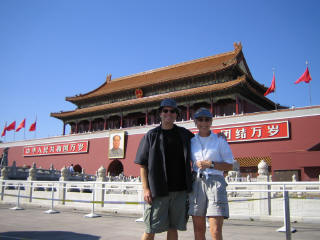
Forbidden City's Gate of
Heavenly Peace |
Beijing is a huge,
relatively clean,
safe city making its transition from third world to new
world status on the backs of billions of dollars, Euros
and Yen. Construction cranes dominate the skyline in
every direction, driven by a red-hot economy and
preparation for the 2008 Olympic Games. Taxis are cheap
and easy to find, while traffic gridlock due to soaring
car ownership and low cost gas is an accepted everyday
fact. |
|
|
Beijing is
rich in historical sites while still very much the
Communist totalitarian capital city of the most populous
country in the world. Traveling with a friend,
Judy O'Dea,
I spent five days based in Beijing, including side trips
to hike the Great Wall of
China on my 50th birthday and to visit the Terra Cotta
Warriors archeological excavation in
Xian, 600 miles southwest. |
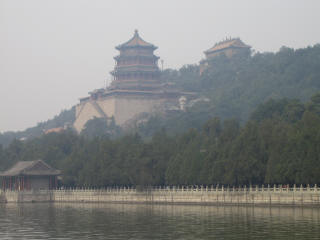
A foggy Summer Palace on Kunming
Lake |
|
Tuesday, September 20th
After my 12
hour flight from San Francisco I arrived in
Beijing around 5pm local time where I was met by a driver I
had hired over the internet. The traffic into Beijing was awful. Just after 7pm I
got to my hotel, the
New World Courtyard, which was unremarkable in every way
except for it's prime location near the center of the city.
After taking over an hour to get my cell phone working on the
China Mobile system, I took a long nighttime walk past the
Gate of Heavenly Peace (first picture above)
and Tiananmen Square to get oriented (no pun intended) and
shake off the long travel day.
Wednesday, September 21st
Judy arrived
from Kuala Lumpur mid-morning and we headed out by taxi to
drop off a deposit at Xinhua Tour Company for our
Xian day trip on Saturday. From
there we taxied to Temple of Heaven Park, a 670 acre nicely
laid out park with gates at each point of the compass. The
famous and beautiful Hall of Prayer for Good Harvests was
closed and covered by scaffolding but the Rose Garden (second
picture above), Imperial Vault of Heaven (third picture
above), Echo Wall (fourth picture above) and Circular Mound
Altar were open and worthwhile. After a quick stop back at the
hotel around lunchtime, we walked to the Forbidden City.
The 15th century Forbidden City,
so called because it was off-limits to commoners for 500 years
during the Ming and Qing dynasties, is the largest imperial
palace in China. Located at the center of Beijing just north
of Tiananmen Square, it contains 800 buildings spread over
180 acres and is completely surrounded by a moat.
The ceremonial buildings proceed south to north beginning just
inside the Gate of Heavenly Peace (large picture top of page
left and first picture above). After passing through the
Meridian Gate and crossing the Golden River on one of five
marble bridges, we entered the first of three buildings which
make up the Outer Court. A large stone
courtyard stands in front of the Hall of Great Harmony atop
its three-tiered marble terrace (first picture below). Behind
it are the smaller Hall of Middle Harmony and the Hall of
Preserving Harmony (second picture below). |
|
We continued
north toward the Inner Court whose layout echoes
the Outer Court but was reserved only for the emperor and high
officials. The first structure is the Gate of Heavenly Purity
(third picture above) with a carved marble ramp and a pair of
bronze lions flanking its entrance. Inside the Inner Court is
the Palace of Heavenly Purity (fourth picture above), the Hall
of Union and the Palace of Earthly Tranquility (first picture
below). Exiting the Forbidden City to the north (second
picture below) we headed east to the Third Ring Road in a taxi
for a cold drink at the Beijing Hard Rock Cafe before having
an excellent, inexpensive and authentic Peking Duck dinner at
the Beijing Dadong Kaoya Dian restaurant.
Thursday, September 22nd
We spent
most of Thursday hiking the
Great Wall of China from Jinshanling to Simatai, returning
to our hotel around 7pm. We cleaned up, changed and were on
our way to an excellent dinner (five course chef's selection
miniatures paired with a great 2003 Scotchman's Hill Shiraz) at
Aria Restaurant on the
second floor of the China World Hotel by 8pm. |
Friday, September 23rd
We hired a
driver for the day (US$100) to tour the Summer Palace, the Lama Temple and to visit the hutongs north and west of the Forbidden City in a rickshaw.
The Summer Palace is an 18th century 290 acre imperial
playground 7 miles northwest of Beijing. The day was foggy
(large picture top of page right - Precious Clouds Pavilion on
the hill) and the palace itself was packed shoulder to
shoulder with tourists. The park was poorly marked, but when
we got lost we found some of the best sights in the quiet
hills off the beaten tourist track. The walk along the lake
(third picture above) was worthwhile, but uninspiring. Our
driver picked us up at the northwest gate and we headed back toward
Beijing to
the Lama Temple. The 17th century Lama Temple is a
very large, authentic example of a Chinese Buddhist temple. It
consists of multiple buildings (fourth picture above) in the
same south to north arrangement as the Forbidden City. It has
ornate incense burners in front of each structure and Buddha
statues inside, the largest of which is over 60 ft. tall.
After the Lama Temple, we were
dropped off just north of the Forbidden City for a rickshaw
tour of some of the oldest remaining hutongs in Beijing.
Hutongs are a collection of thin alleyways, courtyards and
neighborhoods which used to make up most of Beijing's
residential areas. To a western eye they look like terrible
slums (first picture below), but there's more to them here. They are close-knit communities where people know all
their neighbors and generations have come and gone in the same
houses. There's a pattern to the doorways and inner courts
indicating family status and relative wealth. The hutongs are
rapidly disappearing as more modern construction takes over.
Along our tour we went through a food marketplace and saw some
local restaurants before crossing the 12th century Marco Polo
Bridge (second picture below) to stroll along the Back Lakes
region. We ended up at the Drum and Bell Towers northwest of
the Forbidden City. We climbed to the top of the Drum Tower to
get an overhead view of one of the hutongs we had ridden
through (third picture below) and witness the drum ceremony
that announces each half hour to the city below (fourth
picture below). After a quick wine stop at the hotel we headed
out for an extraordinary dinner
at the Courtyard Restaurant, rated one of the best in the
world, located along the eastern moat of the Forbidden City.
Before returning to our hotel, we stopped downstairs to view
the exhibition at the
Courtyard Gallery. |
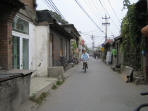 |
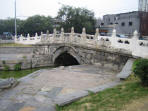 |
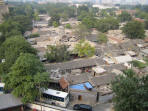 |
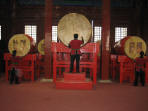 |
Saturday, September 24th
We headed out from our hotel at 5am to Beijing airport for an all-day trip to
China's ancient capital, Xian,
600 miles to the southwest in Shaanxi province. Xian is most
famous for the 2300 year old Qin Shi Huang burial ground
excavation, with its Terra Cotta Warriors and Horses army, one
of the most significant archeological finds of modern times. |

       
Mackey Group, Inc.
© 2002 - 2010
|
|